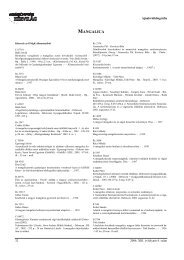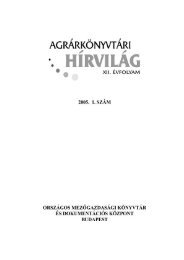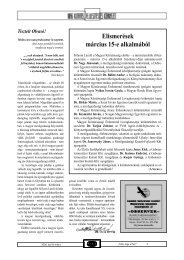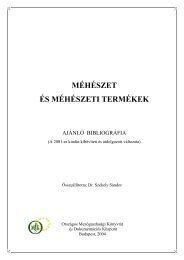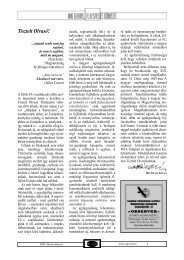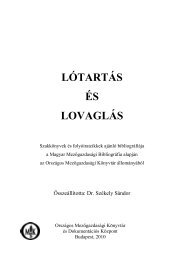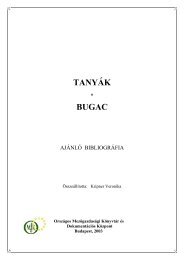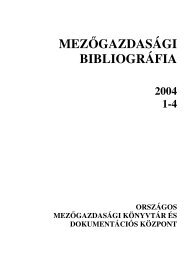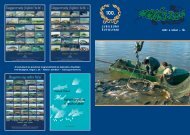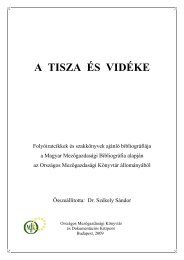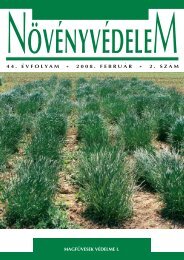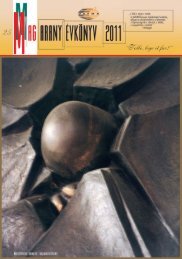hUNGARiAN AGRicUltURAl RESEARch
hUNGARiAN AGRicUltURAl RESEARch
hUNGARiAN AGRicUltURAl RESEARch
You also want an ePaper? Increase the reach of your titles
YUMPU automatically turns print PDFs into web optimized ePapers that Google loves.
mentioned traits – when cultivated<br />
together – should provide a wine<br />
of distinctive characteristics<br />
(Figure 3). During our examinations<br />
the variability of the stock<br />
was also determined, and 56 plants<br />
were assigned for further tests<br />
(Figure 4).<br />
The performance, cluster type,<br />
berry colour and degree of bunch<br />
rotting of these plants were<br />
recorded, and the average weight<br />
of clusters, the sugar and acid<br />
content and pH value of must was<br />
measured. To evaluate the<br />
performance of the chosen plants,<br />
the data were analysed on the basis<br />
of the correlations between the<br />
examined parameters. Figure 5<br />
demonstrates the connection between<br />
the yield and sugar content<br />
of the must of Kadarka parent<br />
vines.<br />
On the basis of the examinations,<br />
17 parent vines were<br />
found to be suitable for the<br />
selection programme (the<br />
reference numbers were generated<br />
by adding 100 to the number of<br />
vine-plant: P.102., P.108., P.109.,<br />
P.111., P.114., P.115., P.117.,<br />
P.122., P.123., P.124., P.125.,<br />
Table 3: Registered and candidate ‘Hungarica’ varieties and clones<br />
developed by the Institute<br />
Number Variety, clone Year of registration<br />
1. Cirfandli 1956<br />
2. Csomorika 1998<br />
3. Furmint P.51 1969<br />
4. Hárslevelû P.41 1971<br />
5. Királyleányka 1973<br />
6. Kadarka P.9 1969<br />
7. Olasz rizling P.2 2003<br />
8. Furmint P.14 2008<br />
9. Furmint P.26 2008<br />
10. Furmint P.27 2008<br />
11. Bakator 2008<br />
Year of application<br />
12. Olasz rizling SK.54 2003<br />
13. Olasz rizling P.10 2004<br />
14. Cirfandli P.123 2004<br />
15. Csókaszôlô 2004<br />
16. Sárfehér 2004<br />
Table 4: Wine appreciation<br />
results (average score, rank)<br />
of candidate clones selected<br />
in medium plot experiments<br />
Szekszárd, 2007<br />
Klón<br />
Átlagos<br />
(100 pon tos<br />
bírálat):<br />
Helyezés<br />
Kadarka P.124 87,3 1<br />
Kadarka P.122 84,2 2<br />
Kadarka P.173 83,9 3<br />
Virághegyi kadarka 83,4 4<br />
Kadarka P.167 83,3 5<br />
Kadarka P.123 82,7 6<br />
Kadarka P.147 81,1 7<br />
Kadarka P.172 81,1 8<br />
Szagos kadarka 79,4 9<br />
Kadarka P.102 78,6 10<br />
Kadarka P.165 77,7 11<br />
Kadarka P.9 77,1 12<br />
Figure 2: Highly variable Kadarka plantation of over the age of<br />
80 years<br />
Hungarian Agricultural Research 2009/3–4 27



